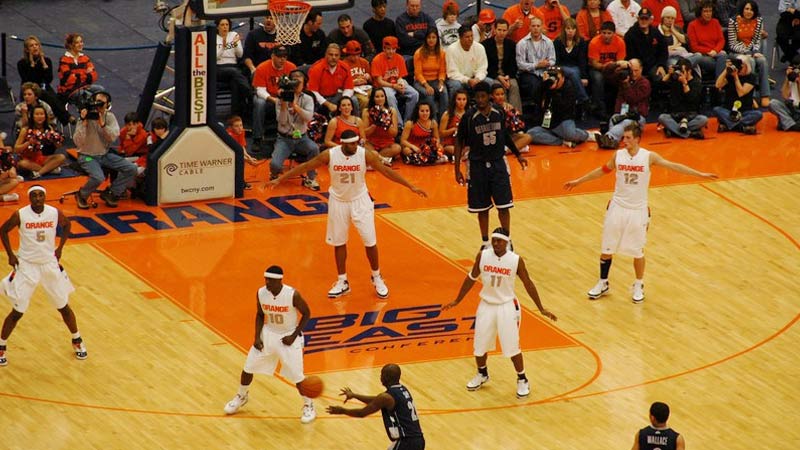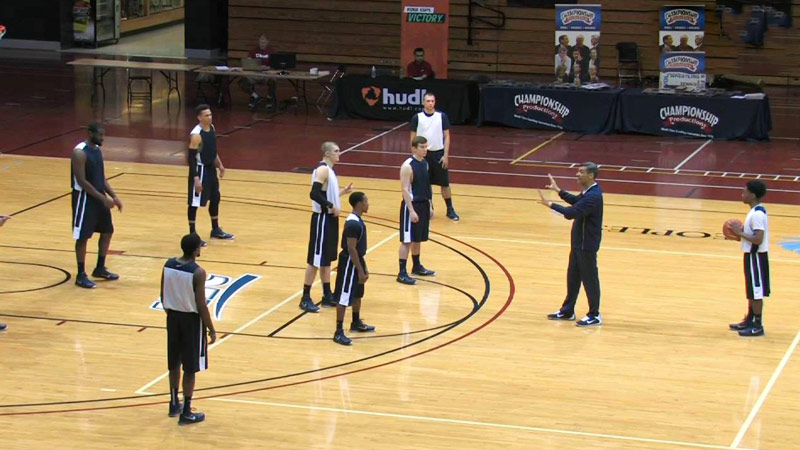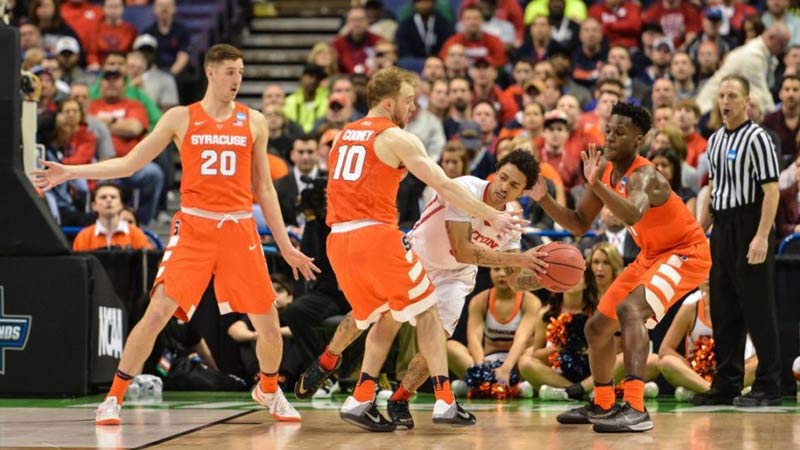Being a defender and not knowing successful defensive strategies to defend your team and prevent the opponent from scoring is not a play!
Here is, 2-3 Zone Defense, the most effective defense when you are all set to nullify your opponent.
It is so common that whenever you hear the word zone on the court, the first thing to knock the coach’s mind will be the 2-3 zone defense.
It is all about time, you scatter your opponent’s mega plan and throw them out of it with this defensive strategy.
Hear out the details!
What is 2-3 Zone Defense?
In basketball, you can have the man-to-man defense or the zone defense where you defend a specific zone on the court.
In 2-3 Zone defense, all players are responsible for defending a designated court area.
In short, it is a popular defensive strategy in basketball where players place themselves on the court to protect designated zones and limit the opponent’s scoring opportunities.
In detail, this defense requires five players. Two players will get across the top of the free-throw zone close to the high post. They are known as Guard 1 and Guard 2.
The other two are the forwards (Forward 3 and Forward 4). The forwards will get outside each block.
And the last one remaining is known as the Center. He stands in the middle of the key.
However, the lineups may vary based on different circumstances. But the role of the five players remains the same mostly.
High Post: Commonly known as the elbows of the court, the high post refers to the area that starts from one corner of the free-throw line to the other corner.
What’s With the Name – 2-3 Zone Defense?
The 2-3 zone defense requires five players in total. The guards (Guard 1 and Guard 2) are the top two players.
They stand around the free throw to the top of the key area and defend all players. They will also block passes (top to the wing including the high post area).
The other three players (Forward 1, Forward 2, and Center) are the bottom players responsible for the corners and players below the free-throw lines. This division in the role leads to the name 2-3 Zone Defense.
What Are The 2-3 Zone Defense Rules?
Source: basketballhq.com
Even though it may seem like a simple trick, you will need to follow these 4 rules for the successful implementation of the 2-3 zone defense.
The 4 rules are:
1) Hands Active & Up
The secret to an effective 2-3 zone defense lies in great passing. You and your team can rule the match with flawless passes inside the court.
Start by holding your hands up and keep them busy in defense. The offense will gradually lose vision, slow down their passes, and have more deflections in basketball.
Adapt to this defensive stance as soon as you can. It will trigger your defensive team members to get more passes or open up the door for more turnover opportunities.
2) Move by the Flight
Follow the flight of the ball, not the catch. Move by the flight and you will naturally find yourself in a defensive position, especially when the offensive player grabs the ball.
However, if you move by the catch, you will have a comparatively poor defense and the offense will have easy-go field goal attempts.
In scenarios like this, make your decision wisely. You don’t want to lag and allow the offense to create more scoring opportunities.
3) Communication Is Tight
Perform any defensive stance and communication is the first thing you will need. No alternative for 2-3 defense as well. Here is a guide to a defensive stance for you.
Establish powerful communication with your teammates and always be transparent about your next stance. This way, you will be able to keep track of the ball, track your opponent’s next move and easily get into the stance that suits you.
Remember all defense has solid communications.
4) Imperishable Defense
Hold your defense tight and make it hard for your opponent. Don’t leave any openings for them to get easy points with layups and such, especially inside the paint.
Utilize the three players on the bottom to reward an unbreakable defense to the opposing team. Build up a triangle network where the center player is ready to defend at every point while the two other players will help them at an instance.
Here are the 4 rules of 2-3 zone defense. But are you the one to perform this zone defense? Or, is it your teammate who can perform it better?
Next, we are going to learn who should be using the 2-3 zone defense and why.
In detail, Basic Rotations of 2-3 Zone Defense

Source: basketballhq.com
You must be thinking, what are offensive teams against? The ball can get into 4 different positions on the court, and so will the defense players.
Here, we will discuss how the players will move across the 2-3 zone defense depending on where the ball is.
1) Top of the Key
The genuine 2-3 zone defense position we mentioned here will prevail with the ball on top of the key.
When the ball is in this position, the best thing that can happen is the ball defender passing the ball to any of the wing players.
Make sure the ball doesn’t get to the high post area. It may scramble the basic alignment of the defenders.
To prevent the ball from going to the high post area, we advise the top guard near the ball handlers to pick up the ball and force pressure while the other guard rejects the high post.
Let the top guards be close to each other so that they can nearly touch hands. The three bottom players will be in the same place unless the ball gets away from the top of the key.
2) Ball on The Wing
When the wing player receives the ball, the bottom player outside will pick the ball. The top players (Guard 1) will come and bump the ball down. In this event, the zone defense position is as followed:
- The ball-side forward (3) player will be in the short corner. Meanwhile, the weak side forward (4) will take a few steps up the lane, to utilize any skip passes.
- Guard (2) – the weak-side one will be near the elbow if no player is available at the high post
- The center player will stand behind to half-front the post player.
Even though it’s up to the coach, the on-top player should get into a neutral defensive stance. Not more, but he should apply some pressure to the offense and make things harder for them to see the court.
3) Corner Ball
The ball-side forward (3) player will come forward and guard the ball with the ball passing to the corner.
Other players will take their stand as follows:
- The center player (5) will proceed to the low post player on the block.
- Guard (1) will get to a help position in the lane, preventing any pass to the high post.
- The weak side Guard (2) ignores the high post if there is one. Otherwise, he will get to the free throw lane area and offer help.
- The forward (4) player will help the players in the low post up in the lane.
Remember that, the corner is a great time to trap. Use the opportunity to your advantage and steal the ball.
4) High Post Ball
After everything, if the ball gets into the high post, your defense may get vulnerable.
Every offensive player on the floor is now only a short pass away and a threat for a quick catch-and-shoot if the offensive team has placed a good passer in the high post (a sensible move).
Players in defense should find themselves in the positions below:
- The center (5) rushes up to play the ball right away.
- The nearest player on their side of the hoop must be quickly “pinch-in” and taken by the two forwards (3 and 4).
- In order to attempt and force the high-post player to pass the ball out, the two guards (1 and 2) must close in on the ball.
However, if the pass is made to either of the wings, they must be prepared to jump out and defend it.
The ball at the high post raises concern for a high-low pass for any genuine layup. Thus, always try to prevent the pass. The best way to do it is not to let the ball get there in the very first place.
Who Will Use the 2-3 Zone Defense?
A successful application of 2-3 zone defense depends on a few things below:
- Ability to read rotation perfectly.
- Applying the right pressure.
- Rebounding missed shots.
Due to the flexibility of 2-3 zone defense, it is suitable for any team and any player. In terms of physical ability, this zone defense is ideal for both slow and fast-paced teams.
A quick tips for 2-3 zone defense for different teams:
- Big and Slow Team: You may have a large yet slow team. If it turns out like this, patience is the only solution for you.
You can also restrict trapping, and wait for the right opportunity to put pressure on the opponent. Few chances are they will rush into moving the ball or attempt shots and make mistakes!
- Small and Fast Team: If you are part of a small yet fast team, use speed to your advantage. Trap often and force your opponent to rush moves.
You, then, have higher scopes of stealing the ball or resulting in a turnover.
Normally, any team can perform the 2-3 zone defense. You only have to manage yourself and your teammates to cope with the zone defense. Remember, one major difference between the 2-3 zone defense with other defenses is, it doesn’t rely on defense only.
Take it seriously as if you are dealing with a man-to-man defense.
Benefits of 2-3 Zone Defense
With two sides of everything, you should also know the advantages and disadvantages of the 2-3 zone defense. Let’s get started with the benefits first.
1) Sudden Strike
Take it proudly! Basketball coaches often overlook the importance of 2-3 zone defense. Instead, they mostly focus on the man-to-man defense.
Meaning, you will merely find teams preparing against the 2-3 zone defense. Hence, there is a 98% possibility that your opponent won’t be prepared for your 2-3 zone defense.
2) Save the Paint
One highlight of 2-3 zone defense is this strategy keeps the basketball away from the hoop as far as possible. Usually, it falls on the center player. As he never leaves the paint zone, he can easily establish it.
The other two bottom players also contribute by setting up a firm stand and guarding the block.
3) Fouls Are Limited
The 2-3 combination is not easy to break. Players simply can’t pass through this strategy, thus it will hold them back from fouling. However, fast-breaking can be a good option to break through the zone defense.
Even so, if your team has this poor habit of getting into foul trouble often, the 2-3 zone defense will be the right card to apply.
4) Invincible Defense
No matter how formidable the 2-3 zone defense is, one can still beat it with smart passing and patience. So, if your opponent is patient enough to wait for the right opportunity, you may have something to fear.
Lucky for you! Most teams are not that patient. You will often find your opponent rushing to move and attempt. When they make hasty decisions of fancy passes, it’s then when you have the opportunity to get the ball.
5) Speed Control
When you set solid zone defense, you can also influence the speed of the match. For example, by setting up a violent trapping zone, you can induce a faster tempo to the match.
On the contrary, set minimum traps and play a patient zone to reduce the speed of the play. It’s fun and optimal.
Drawbacks of 2-3 Zone Defense
Now, let’s take a look at the other side of the 2-3 zone defense.
1) Threat from Outside
When your opponent has a potential and powerful outside shooting team, a 2-3 zone defense may struggle to shine up!
The reason is the 2-3 defense packs the paint so well. Thus, it often overlooks the opening from the outside. You may find yourself out of the zone anytime when a team proceeds with these shots aggressively.
2) No Team, No Defense
The 2-3 zone defense heavily relies on team effort and team members. Each team has a specific role to play on this defense, and together they work as a unit.
The fall of one player will affect the overall build-up of the defense. For example, if one player fails to deliver the right rotation, or takes longer to recover, zone defense members have to cover for him.
Often scenarios like this will lead to openings for your opponent with higher score possibilities.
3) Not So Easy Decision
The number one obstacle you will face in a 2-3 zone defense is figuring out who fits where. For any zone, coaches define beforehand who should be guarding the ball and who would take the paint.
However, in events like skip passes or reversal of the ball, to your unawareness, the ball may end up being open to the opposing team.
4) Freedom to Select (Offense)
In 2 – 3 zone defense, an offensive team can often decide if they want their top player to match up against your weak player. And they can! You can only wish that they lost by dribbling.
5) Rebounding Is A Problem
With weak matchups in zone defense, rebounding is always a challenge. And in the 2-3 zone defense, players don’t specifically have matchups, they only guard the paint. Keep this in mind.
Learn more about rebounding here.
How to Attack A 2-3 Zone Defense?
Until now, we talked about developing the zone defense and how it may affect the offense. Now, let’s give a hand to the offense and find out how they may break this formidable defense strategy.
- Do not rush into a three-point shot. Not unless it comes as a direct outcome of an offensive action.
- Instead, go for the one-pass shot, or reverse ball shot to have the defense off the hook.
- The zone moves with each pass, take your set positions carefully. The opening only appears when more than just the ball moves.
- Look for the lanes to strike the board with missed shots. You can drive good scoring opportunities from these few openings.
- Learn how to screen the zone. Screening often pushes the defense to readjust their alignments. And if they don’t adjust, it is another privilege for you with more openings.
- You can also develop a continuity offense. It works efficiently against the 2-3 zone defense. However, one drawback of continuity offense is, the defense will be aware that the cuts are coming.
Last Words
We are ‘almost’ at the end of our in-depth article on zone defense. ‘Almost’ because, this shouldn’t be the one zone defense you should be counting on.
First, learn your team’s requirements. Then apply the 2-3 zone defense and find out how your opponent responds to it. You can always shift your defense strategy whenever you feel like it.
But being more tactical with defensive strategies will increase your chance to win! You can also get into the drills to try out and figure out how it works for you.
Next, we are coming up with 131 Zone Defense. Stay with us for more.








